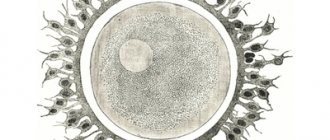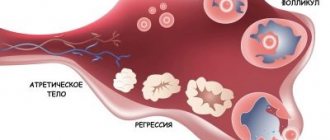During fertilization, the fusion of gametes occurs. During this process, the male and female genetic material are combined and the diploid set of chromosomes is restored (each cell contains 46 chromosomes, only the sex cells have a half set, that is, 23 chromosomes). For fertilization to take place, it is necessary that sperm reach the egg as quickly as possible, and at the same time the strongest cells retain their viability.
The article will discuss how long it takes sperm from ejaculation to fertilization of the egg.
The influence of progesterone in the process of conception
Undoubtedly, every fertilization begins with the process of ovulation, which begins on the 13-14th day of the menstrual cycle. It is during this period that the egg matures. After this, the follicle ruptures and the egg is released. This process is called ovulation.
Conception occurs during ovulation, so it is important not to miss this moment
Some women may feel pain at this moment, which passes very quickly. If fertilization has occurred, the formed corpus luteum continues to function.
The following features of progesterone can be distinguished for the entire process of conceiving a child:
- thanks to progesterone, certain changes occur in the human body, which create the necessary conditions for the occurrence and further development of pregnancy;
- in order for the attachment of the fertilized egg and its further development to occur, the influence of progesterone is also necessary, since it is he who is responsible for the stages and phases of secretion;
- It is this hormone that is necessary to significantly reduce the sensitivity and excitability of the uterus, and thanks to this, prevent rejection and eliminate the risk of spontaneous abortion.
It has been scientifically proven that it is as a result of the lack of ovulation that most cases of infertility develop.
Conditions for conception
How long does it take for a sperm to reach the egg after being released into the vagina? It has long been proven that this process takes no more than three minutes. During the period of conception, sperm first have to overcome the acidic and destructive environment of the uterus, and also try to survive among all and get into the uterine cavity.
In order for fertilization to be successful, the following conditions must be met:
- presence of mobile and healthy sperm;
- a sufficient amount of sperm released during ejaculation;
- the egg is completely ready for fertilization;
- ovulation period.
Note! The time for sperm is limited, since the egg, which is ready for fertilization and released from the follicle, lives for one day; after this period, conception cannot occur.
After leaving the follicle, the egg lives for 24 hours
Among other things, for successful fertilization, a man’s ejaculate must contain at least half a billion sperm, but even despite this, in most cases only one can reach the egg for fertilization, but, as practice shows, there are exceptions when it comes to multiple pregnancy pregnancy. As for the exact period during which fertilization takes place, it is impossible to answer this question precisely, since this completely depends on the quality, quantity and speed of male sperm, as well as on the successful overcoming of obstacles in the vagina, of which there are many. Approximately, we can say that the genetic material enters the uterine cavity after about two hours.
I would also like to note the fact that the place of attachment is of great importance for the development and further growth of the unborn child. Here, of course, nothing depends on the woman herself, but it is worth knowing that in most cases, improper attachment can cause the development of placental insufficiency.
How many sperm are in semen
According to the recommendations of the World Health Organization, normal sperm parameters are as follows:
- volume – from 1.5 ml and more;
- the number of germ cells in a portion of ejaculate is at least 39 million;
- number of sperm per milliliter of semen – from 15 million;
- a portion of sperm may contain at least 40% motile sperm;
- cells with progressive movement can be from 32% or more (this means that male germ cells move along a straight path at a speed of approximately 25 microns per second);
- a portion of sperm may contain up to 58% viable sperm;
- normal forms of male germ cells may be more than 4%.
Normal seminal fluid after ejaculation is viscous. It liquefies within a maximum of an hour. If this does not happen for more than an hour, then the sperm is considered to have pathological viscosity.
Sex cells with progressive movement (active or weakly mobile) can reach the egg. Poorly motile sperm increase their motility after capacitation in the cervix.
The appearance of antisperm antibodies in the ejaculate indicates the development of infertility of the immune system. Due to the presence of these bodies, sperm cannot attach to the oocyte and initiate the acrosomal reaction.
Ovulation
After a woman achieves sexual intercourse, she undergoes the process of ovulation every month. This process in the female body is considered very complex. During this process, fertilization occurs. The fusion of the egg with the sperm occurs within twelve hours after the egg leaves the fallopian tube. Every woman can calculate this period in her life depending on her menstrual cycle. In addition, you can determine the time of ovulation by measuring rectal temperature.
In order to get accurate readings, you should measure your temperature every day for several months at the same time. All results obtained should be recorded, since this is the only way to clearly determine the period of ovulation.
To determine ovulation, there are special tests that are sold in pharmacies.
In order to get pregnant, you need to choose the most favorable moment for this, which occurs at the time of ovulation, as well as a few days before it begins.
Obstacles on the way to the egg
Not all sperm can make it to the egg. There are many obstacles on this path.
- Changes in the properties of seminal fluid due to inflammation of the prostate gland. This organ produces special substances that improve the movement of sperm through the female genital tract and increase their viability time.
- Hormonal pathologies in the male body, and, as a result, changes in the biochemistry of sperm.
- Increased thickness of cervical mucus. Pathology is indicated when the mucus does not liquefy during ovulation.
- Weak contractile movements of the cervix or body of the uterus. They are associated with hormonal imbalance and other pathologies.
- Disturbances in the process of sperm formation (for example, disturbances in structure, motility and activity).
- Violation of the acid and alkaline balance in the body of a woman or a man. Various infections can contribute to this.
- Various ejaculation disorders.
Dead spermatozoa decompose. The remaining semen flows out of the vagina. Some of the sperm breakdown products are absorbed by the vaginal wall and enter the body.
Usually the sperm reaches the egg within several hours (maximum - up to 12). During this time, only the strongest and most mobile cells can reach the goal and give rise to a new life.
How does fertilization occur?
During sexual intercourse, a huge number of sperm strive to get into the uterine area, but not all achieve the desired result, since the harmful acidic environment of the vagina affects them and simply kills them. In order to achieve the result, sperm travel the entire lengthy path of about twenty centimeters. Given that the sperm move at an average speed, it will only take a few hours to achieve results.
In most cases, only one sperm participates in the fertilization process; all the others die. Next, the sperm will have to face additional obstacles. To overcome them, the sperm needs to break through the coating of the female egg using intense thrusts. As soon as he succeeds during this period, fertilization occurs and the resulting cell is called a zygote.
After all this, the zygote begins its division and then moves along the fallopian tube towards the uterus. After it reaches the uterus, and this happens approximately on the seventh day, an embryo is formed that is fully prepared for implantation.
The process of conception: thousands of sperm trying to get inside the egg
In order for the fertilized egg to successfully attach to the uterus, certain conditions must be met, which are as follows:
- the thickness of the endometrium must be appropriate, which plays an important role for the subsequent development of the embryo;
- the endometrium must contain the required amount of nutrients;
- a woman’s body must have the required concentration of progesterone, which exceeds the norm in terms of indicators.
If the conditions are not met, this will lead to the fact that the fertilized egg simply will not be able to attach to the uterine lining and, in turn, such processes will lead to the onset of bleeding and, accordingly, to the process of rejection of the embryo. In some situations, conception may even occur a little later than 24 hours after ovulation, since some eggs can boast a long lifespan, sometimes reaching 48 hours. After this, cell destruction occurs. But the formation of new ones can occur only after one month.
Path of the sperm
After ejaculation, sperm enters the vagina. It maintains a highly acidic environment that is harmful to sperm. However, sperm is alkaline, and the overall acidity level decreases for a while. This allows sperm to survive, although not all, but only the strongest.
The sperm then penetrate the cervix. Sperm accumulates in the posterior fornix of the vagina. The cervix is covered with cervical mucus with a slightly alkaline reaction. This reaction does not kill sperm. Mucus usually has a thick consistency, but during ovulation it becomes thin. Such conditions facilitate the penetration of sperm into the uterine cavity. Again, only the strongest male reproductive cells can do this.
The walls of the cervix are pushed inward, and its contents move towards the fallopian tubes - this is where the egg is located. Here is the most comfortable environment for preserving the vital activity of sperm. And thanks to special processes, they begin to move very quickly. Only the most active sperm can penetrate the egg (oocyte). Thanks to the contraction of the fallopian tubes, sperm move towards the oocyte even more actively.
Before reaching the egg, sperm need to pass one final barrier. They overcome it during penetration. The first barrier is the corona radiata of the egg. Only the strongest male reproductive cell can break through it.
The other layer is called the zona pellucida. It breaks through only thanks to a special bubble - an acrosome. The acrosome contains enzymes that dissolve the membrane of the female reproductive cell. As soon as the sperm reaches the target (the center of the oocyte, which is called the oolemma), the penetration process stops. Sperm residues are necessary in order to create the most favorable conditions for sperm.
How does a woman feel during the process of fertilization?
We have already decided how long it takes for the sperm to reach the egg, now let's figure out whether the woman feels any special feelings at this moment. After fertilization of the egg occurs, women still experience some symptoms. The woman exhibits the following symptoms:
- breathing intensity changes. This symptom is explained by the fact that the zygote experiences an oxygen need during its formation;
- a woman’s appetite increases and taste preferences change, this occurs due to changes in metabolism;
- the level of free amino acids increases.
Despite the fact that such symptoms have been confirmed by many scientists, they are still so subtle that it is almost impossible for women to detect them in everyday life and a very low percentage of women can feel such minor changes in their bodies.
In addition, theoretically, a woman may experience the following signs of a developing pregnancy immediately after fertilization:
- this is the appearance of pain in the area of the ovaries and lower abdomen, they can be mild or have a pulling nature;
- increased emotionality, susceptibility to depressive situations and unreasonable attacks of anger;
- systematic fatigue, lethargy, weakness, drowsiness;
- swelling and tenderness of the mammary glands.
But as many years of medical practice have shown, all of the listed symptoms can be so mildly expressed that a woman may not notice them at all. There are situations when a woman who dreams of becoming a mother can feel even the slightest changes in her body, and vice versa, if pregnancy is not desirable, then no sensations will be noticed.











